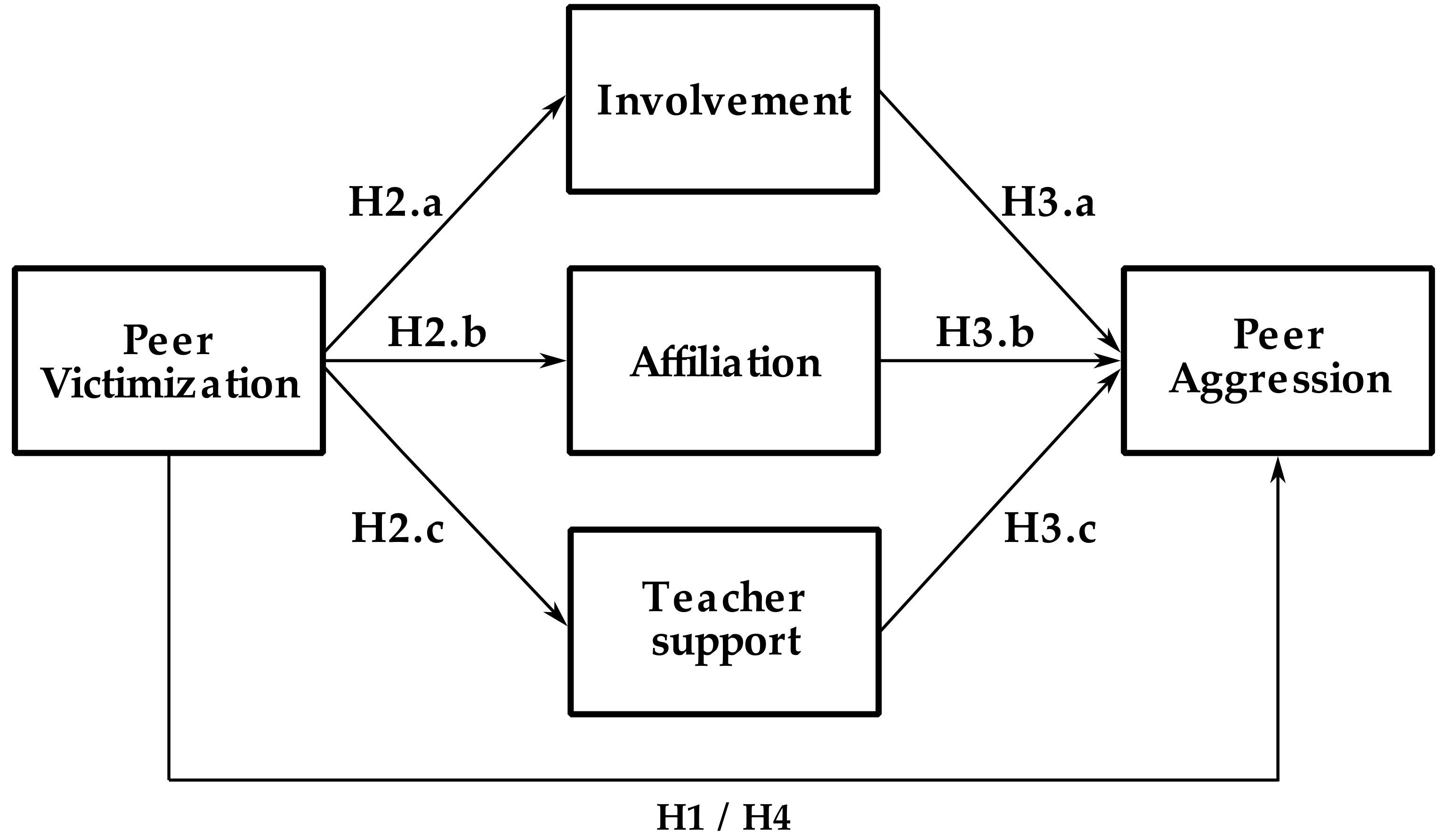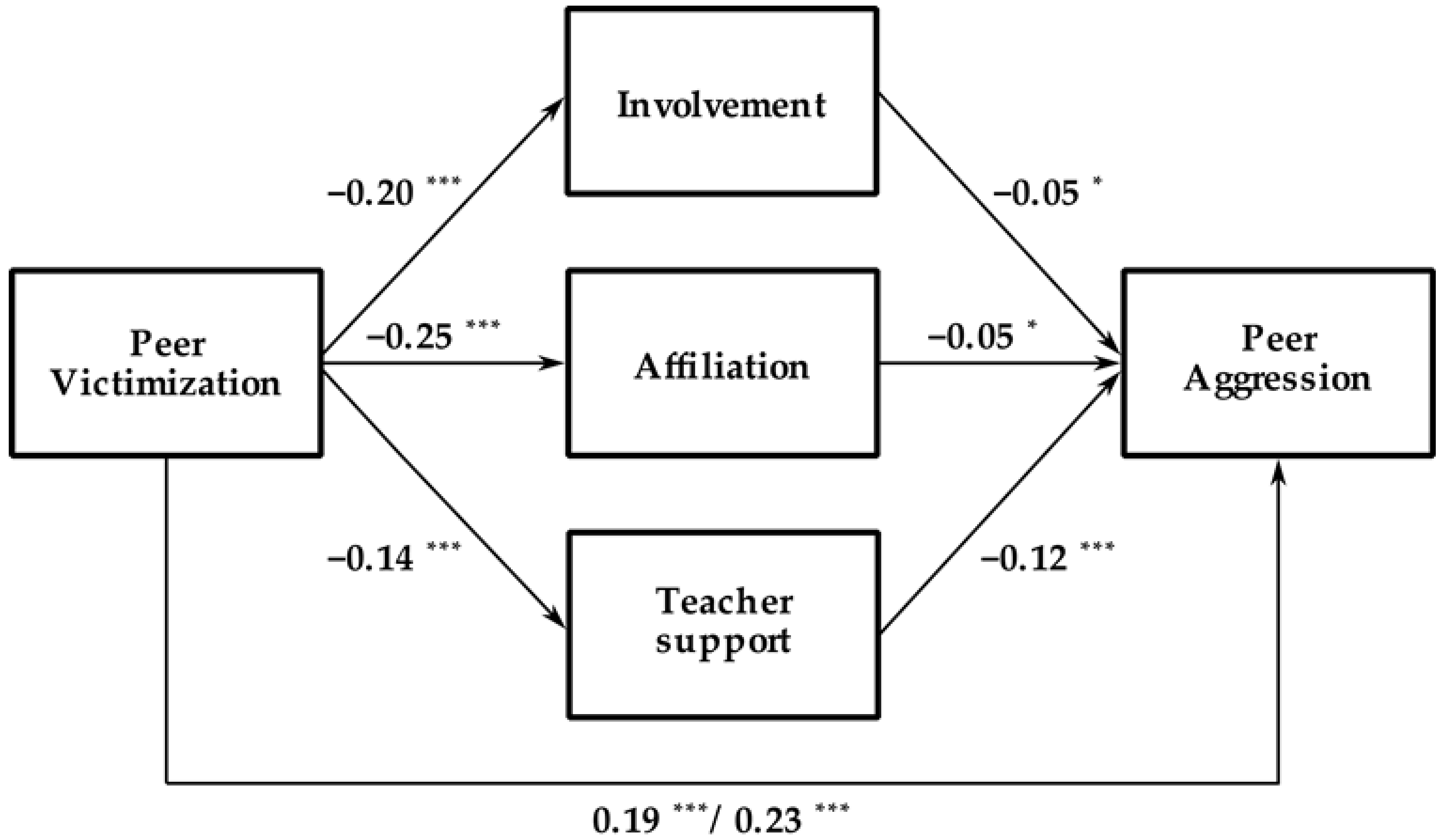The Mediating Role of Classroom Climate on School Violence
Abstract
1. Introduction
Peer Victimization, Peer Aggression, and Classroom Climate
2. Materials and Methods
2.1. Participants and Procedure
2.2. Instruments
2.3. Statistical Analysis
3. Results
Mediation Analyses
4. Discussion
Limitations
5. Conclusions
Author Contributions
Funding
Institutional Review Board Statement
Informed Consent Statement
Conflicts of Interest
References
- Olweus, D. Aggression in the Schools: Bullies and Whipping Boys; John Wiley and Sons: Hoboken, NJ, USA, 1978; ISBN 978-0470993613. [Google Scholar]
- Hodgins, M. Taking a health promotion approach to the problem of bullying. Int. J. Psychol. Psychol. Ther. 2008, 8, 13–23. [Google Scholar]
- Ortega, R.; Calmaestra, J.; Merchán, J.M. Cyberbullying. Int. J. Psychol. Psychol. Ther. 2008, 8, 183–192. [Google Scholar]
- Bellmore, S.; Graham, A.D. Peer Victimization and Mental Health During Early Adolescence. Theory Pract. 2007, 46, 138–146. [Google Scholar]
- Espelage, D.L.; Bosworth, K.; Simon, T.R. Examining the social context of bullying behaviors in early adolescence. J. Couns. Dev. 2000, 78, 326–333. [Google Scholar] [CrossRef]
- Garcia, O.F.; Serra, E.; Zacares, J.J.; Calafat, A.; Garcia, F. Alcohol use and abuse and motivations for drinking and non-drinking among Spanish adolescents: Do we know enough when we know parenting style? Psychol. Health 2020, 35, 645–664. [Google Scholar] [CrossRef] [PubMed]
- Martínez, I.; Murgui, S.; Garcia, O.F.; Garcia, F. Parenting in the digital era: Protective and risk parenting styles for traditional bullying and cyberbullying victimization. Comput. Hum. Behav. 2019, 90, 84–92. [Google Scholar] [CrossRef]
- Garcia, F.; Serra, E.; Garcia, O.F.; Martinez, I.; Cruise, E. A third emerging stage for the current digital society? Optimal parenting styles in Spain, the United States, Germany, and Brazil. Int. J. Environ. Res. Public Health 2019, 16, 1–20. [Google Scholar] [CrossRef]
- Montero-Montero, D.; López-Martínez, P.; Martínez-Ferrer, B.; Moreno-Ruiz, D. Parenting dimensions and adolescent peer aggression: A gendered analysis. Sustainability 2020, 12, 6522. [Google Scholar] [CrossRef]
- López, E.E.; Pérez, S.M.; Ochoa, G.M.; Ruiz, D.M. Moreno David Musiti G. Clima familiar, clima escolar y satisfacción con la vida en adolescentes. Rev. Mex. Psicol. 2008, 25, 119–128. [Google Scholar]
- Trickett, E.J.; Leone, P.E.; Fink, C.M.; Braaten, S.L. The Perceived Environment of Special Education Classrooms for Adolescents: A Revision of the Classroom Environment Scale. Except. Child. 1993, 59, 411–420. [Google Scholar] [CrossRef]
- Martínez-Ferrer, B.; Povedano-Díaz, A.; Amador-Muñoz, L.V.; Moreno-Ruiz, D. Clima escolar, satisfacción con la vida y victimización en la escuela. un análisis del efecto moderador del género. An. Psicol. 2012, 28, 875–882. [Google Scholar] [CrossRef][Green Version]
- Delgado, B.; Escortell, R.; Martínez-Monteagudo, M.C.; Ferrández-Ferrer, A.; Sanmartín, R. Cyberbullying, Self-concept and Academic Goals in Childhood. Span. J. Psychol. 2019, 22, E46. [Google Scholar] [CrossRef]
- Cohen, J.; Mccabe, E.M.; Michelli, N.M.; Pickeral, T. School climate: Research, policy, practice, and teacher education. Teach. Coll. Rec. 2009, 111, 180–213. [Google Scholar]
- Nakamoto, J.; Schwartz, D. Is peer victimization associated with academic achievement? A meta-analytic review. Soc. Dev. 2010, 19, 221–242. [Google Scholar] [CrossRef]
- Blankemeyer, M.; Flannery, D.J.; Vazsonyi, A.T. The role of aggression and social competence in children’s perceptions of the child–teacher relationship. Psychol. Sch. 2002, 39, 293–304. [Google Scholar] [CrossRef]
- Molpeceres, M.; Llinares Insa, L.; Bernad, J. La percepción de las figuras de autoridad fomales e informales y la inclinación a la conducta delictiva en la adolescencia: Un análisis preliminar de sus relaciones. Interv. Psicosoc. 1999, 8, 349–367. [Google Scholar]
- Quijada, A.; Ruiz, M.A.; Huertas, J.A.; Alonso-Tapia, J. Development and validation of the school climate questionnaire for secondary and high school teachers (SCQ-SHST). An. Psicol. 2020, 36, 155–165. [Google Scholar]
- Eugene, D.R.; Crutchfield, J.; Robinson, E.D. An examination of peer victimization and internalizing problems through a racial equity lens: Does school connectedness matter? Int. J. Environ. Res. Public Health 2021, 18, 1–18. [Google Scholar] [CrossRef] [PubMed]
- Moreno Ruiz, D.; Estévez López, E.; Murgui Pérez, S.; Musitu Ochoa, G. Relationship between family and school environments: The role of empathy, attitude to authority and violent behavior in adolescence. Int. J. Psychol. Psychol. Ther. 2009, 9, 123–136. [Google Scholar]
- Estévez López, E.; Pérez, S.M.; Ochoa, G.M.; Ruiz, D.M. Adolescent aggression: Effects of gender and family and school environments. J. Adolesc. 2008, 31, 433–450. [Google Scholar] [CrossRef]
- Gottfredson, G.D.; Gottfredson, D.C.; Payne, A.A.; Gottfredson, N.C. School climate predictors of school disorder: Results from a national study of delinquency prevention in schools. J. Res. Crime Delinq. 2005, 42, 412–444. [Google Scholar] [CrossRef]
- World Medical Asociation. World Medical Association Declaration of Helsinki. JAMA 2013, 310, 2191–2194. [Google Scholar] [CrossRef] [PubMed]
- Martínez-Ferrer, B.; Moreno, D.; Musitu, G. Are adolescents engaged in the problematic use of social networking sites more involved in peer aggression and victimization? Front. Psychol. 2018, 9, 801. [Google Scholar] [CrossRef] [PubMed]
- Little, T.D.; Henrich, C.C.; Jones, S.M.; Hawley, P.H. Disentangling the “whys” from the “whats” of aggressive behaviour. Int. J. Behav. Dev. 2003, 27, 122–133. [Google Scholar] [CrossRef]
- Ferrer, B.M.; Ochoa, G.M.; Muñoz, L.V.A.; Gimeno, M.C.M. Estatus sociométrico y violencia escolar en adolescentes: Implicaciones de la autoestima, la familia y la escuela. Rev. Latinoam. Psicol. 2012, 44, 55–66. [Google Scholar]
- Mynard, H.; Joseph, S. Development of the multidimensional peer-victimization scale. Aggress. Behav. 2000, 26, 169–178. [Google Scholar] [CrossRef]
- Moos, R.H.; Trickett, E.J. Classroom Environment Scale Manual; Consulting Psychologist Press: Palo Alto, CA, USA, 1973. [Google Scholar]
- Hayes, A.F. Introduction to Mediation, Moderation, and Conditional Process Analysis: A Regression-Based Approach; The Guilford Press: New York, NY, USA, 2017; ISBN 9781609182304. [Google Scholar]
- Bolin, J.H. Andrew F. Hayes (2013). Introduction to Mediation, Moderation, and Conditional Process Analysis: A Regression-Based Approach. New York, NY: The Guilford Press. J. Educ. Meas. 2014, 51. [Google Scholar] [CrossRef]
- Modecki, K.L.; Minchin, J.; Harbaugh, A.G.; Guerra, N.G.; Runions, K.C. Bullying prevalence across contexts: A meta-analysis measuring cyber and traditional bullying. J. Adolesc. Health 2014, 55, 602–611. [Google Scholar] [CrossRef] [PubMed]
- Goldbach, J.T.; Sterzing, P.R.; Stuart, M.J. Challenging Conventions of Bullying Thresholds: Exploring Differences between Low and High Levels of Bully-Only, Victim-Only, and Bully-Victim Roles. J. Youth Adolesc. 2018, 47, 586–600. [Google Scholar] [CrossRef] [PubMed]
- Schwartz, D.; Proctor, L.J.; Chien, D.H. The aggressive victim of bullying: Emotional and behavioral dysregulation as a pathway to victimization by peers. In Peer Harassment in School: The Plight of the Vulnerable and Victimized; Guilford Press: New York, NY, USA, 2001; ISBN 1572306270. [Google Scholar]
- Runions, K.C.; Salmivalli, C.; Shaw, T.; Burns, S.; Cross, D. Beyond the reactive-proactive dichotomy: Rage, revenge, reward, and recreational aggression predict early high school bully and bully/victim status. Aggress. Behav. 2018, 44, 501–511. [Google Scholar] [CrossRef]
- Reddy, R.; Rhodes, J.E.; Mulhall, P. The influence of teacher support on student adjustment in the middle school years: A latent growth curve study. Dev. Psychopathol. 2003, 15, 119–138. [Google Scholar] [CrossRef] [PubMed]
- Jolliffe, D.; Farrington, D.P. Empathy and offending: A systematic review and meta-analysis. Aggress. Violent Behav. 2004, 9, 441–476. [Google Scholar] [CrossRef]
- Farrington, D.P.; Loeber, R.; Yin, Y.; Anderson, S.J. Are within-individual causes of delinquency the same as between-individual causes? Crim. Behav. Ment. Health 2002, 12, 53–68. [Google Scholar] [CrossRef] [PubMed]
- Mateos, N.E.; Palacios, E.G.; Fernández-Zabala, A.; Antonio-Agirre, I. Internal structure, reliability and invariance across gender using the multidimensional school climate scale pace-33. Int. J. Environ. Res. Public Health 2020, 17, 1–24. [Google Scholar]


| Variables | Rank | Min. | Max. | M | SD |
|---|---|---|---|---|---|
| 1. Peer Aggression | 1.78 | 1.00 | 2.78 | 1.396 | 0.256 |
| 2. Peer Violence | 2.66 | 1.00 | 3.66 | 1.412 | 0.345 |
| 3. School Involvement | 1.00 | 1.00 | 2.00 | 1.447 | 0.204 |
| 4. Affiliation | 0.90 | 1.10 | 2.00 | 1.720 | 0.169 |
| 5. Teacher Support | 1.00 | 1.00 | 2.00 | 1.592 | 0.220 |
Publisher’s Note: MDPI stays neutral with regard to jurisdictional claims in published maps and institutional affiliations. |
© 2021 by the authors. Licensee MDPI, Basel, Switzerland. This article is an open access article distributed under the terms and conditions of the Creative Commons Attribution (CC BY) license (http://creativecommons.org/licenses/by/4.0/).
Share and Cite
Montero-Montero, D.; López-Martínez, P.; Martínez-Ferrer, B.; Moreno-Ruiz, D. The Mediating Role of Classroom Climate on School Violence. Int. J. Environ. Res. Public Health 2021, 18, 2790. https://doi.org/10.3390/ijerph18062790
Montero-Montero D, López-Martínez P, Martínez-Ferrer B, Moreno-Ruiz D. The Mediating Role of Classroom Climate on School Violence. International Journal of Environmental Research and Public Health. 2021; 18(6):2790. https://doi.org/10.3390/ijerph18062790
Chicago/Turabian StyleMontero-Montero, David, Paula López-Martínez, Belén Martínez-Ferrer, and David Moreno-Ruiz. 2021. "The Mediating Role of Classroom Climate on School Violence" International Journal of Environmental Research and Public Health 18, no. 6: 2790. https://doi.org/10.3390/ijerph18062790
APA StyleMontero-Montero, D., López-Martínez, P., Martínez-Ferrer, B., & Moreno-Ruiz, D. (2021). The Mediating Role of Classroom Climate on School Violence. International Journal of Environmental Research and Public Health, 18(6), 2790. https://doi.org/10.3390/ijerph18062790








